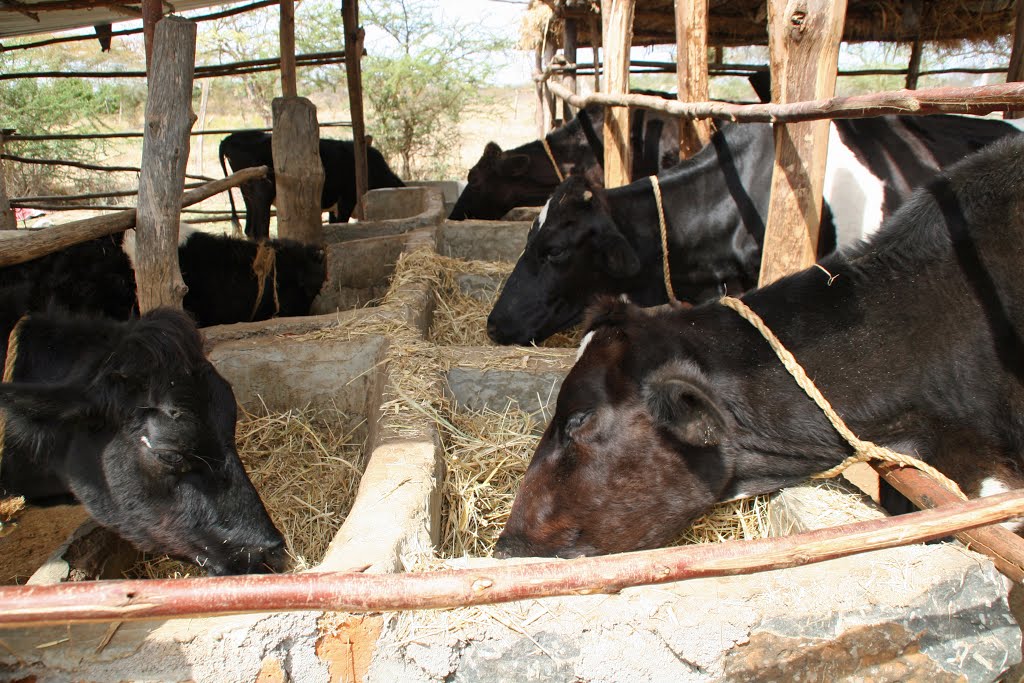 By George Munene
By George Munene
In dairy farming, getting a handle on feeding is the single most important determinant of the profitability of your farm. It is the basis of production, growth, health and body condition.
Yakub Bachu, an animal husbandry expert and Peter Chirchir, a veteran dairy farmer at Kericho with a milking herd of 24 cows averaging 25 litres between them offer practical tested insight on what and how much to feed your cow at various stages of growth to maximise on their potential:
Calf to weaning
- The first hour of calf determines the health of the calf.
- Colostrum is the first milk of the cow rich in antibodies and provides immunity to the calf.
- It is recommended the calf receive two litres of colostrum within an hour
- It is recommended for the next three to four days.
- In case a mother dies artificial colostrum can be fed as 0.5milk + one egg +0.5 warm water +one teaspoon cod liver + one teaspoon castor oil
- On day four to five start feeding whole milk—one kilogram per day for 10kg live weight fed twice a day
- Bottle feeding can be done up to day four then you can introduce bucket feeding by inserting two fingers into the bucket & lowering the head of the calf with its mouth into the bucket.
Related News: Farmers suffer milk collapse on changing cows’ environment
Related News: Fact Sheet: physical traits of a good dairy cow
Maintaining good hygiene is of utmost importance as the calf is easily susceptible to diseases given its immune system is as yet not fully developed.
- High-quality feeds are critical to successful early weaning. Gradually introduce good quality forage from about two to three weeks of age. This stimulates rumen development and reduces problems of scours. Introduce calf pellets/starter at about the same time pasture is introduced.
- Feed is gradually increased so that by 12 weeks of age the calf is receiving one to two kilograms per day.
- Any change of feed should be done slowly over a seven day period.
- Feed whole milk at eight to ten per cent of body weight per day.
- Economics dictate that the calf should be fed &managed to transform it to a ruminant as earliest as possible age. Provide at least 10litres of water per day at all times especially when calf begins eating solid feed.
For his calves Peter Chirchir separates them from their mother on the second day after their birth and feeds them on six litres of milk for their first month, four litres for the second and two litres for the third month. In the fourth month, he feeds them on one litre of milk for the first week and begins to wean them on the second. He feeds them on calf pellets beginning on the first week after their birth.
Weaning
- Prolonged whole milk feeding reduces profits for the dairy farmer especially when the calf is able to obtain required nutrients from solid feeds. The time to wean, however, varies from one farmer to the next and depends on;
- Physical body
- Feed consumption
- Body weight
- Calves should be weaned gradually when they are eating one to two kilograms calf starter per day.
- Usually calves can be weaned at four to eight weeks of age. This practice not only reduces costs associated with high price of liquid feeds, but reduces calf scours. Weaning may be delayed when the weather is cold or calves are weakened by previous or existing illness.
- Small breed calves need 9 to 10more days of liquid feeding.
Feeding weaned calf
- Calf should be housed individually until they are 9 to 10 weeks of age. High-quality pasture may be offered in limited quantities after weaning.
- Forage legume like njahi/lablab have a high nutrient content but grasses like hay or a mixture of lablab-grass pasture cut at early maturity may be more palatable. Continue to feed calf starter &limited quantities of pasture until starter intake reaches 2kg per day.
- At this stage calves can be switched to a less expensive concentrate that will adequately supplement the forage feed.
For Chirchir, beginning on the second week of the fourth month he feeds his weaned calves on an ad-libitum mixture of silage, hay and napier grass.
Related News: Salt supplements prevent milk fever, retained placenta and downer cow disease in cows after giving birth
Feeding the heifer from 4months to calving
- Once a heifer has switched from calf to starter to less expensive concentrate, forage quality is still important as dry matter intake is relatively low &energy requirements are high.
- Breeding age heifers should be fed and managed as a separate group. Optimum conceptions observed in heifer possessing adequate size (300 to 400kgs) for fresians,250 to 300 kgs for crossbred animals. If the heifers do not conceive on the first service, add a limited intake of forage fed to the lactating herd. Too much may lead to over conditioning.
For his heifers, Chirchir feeds them on a 20kg mixture of hay + silage, 1 kg of standard dairy meal from weening, increasing to 2/3kg on the eighth/ninth months. An equal amount of a mix of maize + wheat germ acts as a suitable substitute for dairy meal. He also begins to feed them on calf salts (100 grams of vital ndama) from the seventh month.